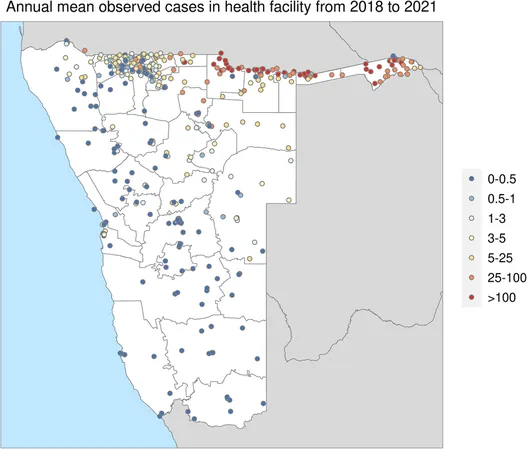
Pioneering High-Resolution Risk Mapping: A Game-Changer in the Battle Against Malaria in Namibia
2024-10-05
Introduction
Malaria continues to be a formidable public health challenge across the globe, but recent advancements in Namibia are paving the way for potentially groundbreaking results in malaria elimination strategies. As a low malaria transmission country in sub-Saharan Africa, Namibia has impressively cut back its malaria burden through various interventions, including indoor residual spraying, distribution of long-lasting insecticidal nets, and improved access to rapid diagnostic tests and effective treatments. With an ambitious aim of eliminating local malaria cases by 2027, Namibia is strategizing to tackle increasingly isolated pockets of transmission.
Innovative Research
The innovative research recently undertaken seeks to address the pressing need for hotspot identification in Namibia. This study identifies periods during which local malaria cases exceed one case per 1,000 person-years observed (PYO) in different districts, generating risk maps that achieve unprecedented spatio-temporal resolution. Understanding these patterns is critical as Namibia approaches its target of eradicating local malaria by 2030 as part of the Elimination Eight Initiative alongside seven other southern African nations.
Progress and Challenges
Despite notable progress—dropping from a staggering 47.5 cases per 1,000 population in 2017 to just 10.62 in 2021—certain northern regions have experienced periodic outbreaks, particularly spiking during the peak transmission months of April and May. The rich geographical diversity of Namibia complicates malaria transmission dynamics; it includes vast differences in population density and contrasting environmental conditions. The Namib desert, Great Escarpment, and the Kavango-Zambezi area are just a few examples of the diverse landscapes that shape malaria transmission in the region.
Statistical Modeling and Mapping
Harnessing cutting-edge statistical modeling that integrates a variety of environmental factors and clinical case data, the researchers developed a comprehensive mapping approach. By utilizing data from 397 geo-located health facilities, researchers achieved an astonishing overall case reporting completeness of 81.68% over three years, facilitating accurate predictive models that identify seasonal fluctuations and geographic variations in malaria risk.
Game-Changing Risk Mapping Technology
The high-resolution risk maps produced by this study are not just impressive visuals; they are actively used by the Namibian Ministry of Health and Social Services' National Vector-Borne Diseases Control Programme (NVDCP) for tailoring malaria intervention strategies. These maps are instrumental in prioritizing regions for prevention initiatives—where the risk is highest.
Adopting a two-stage approach for modeling, researchers have effectively pinpointed local risk variations both spatially and temporally. This method allows health officials to quickly respond to emerging hotspots with precision-targeted interventions.
Findings and Correlations
There are distinct findings from the data as well. The overall malaria incidence rate in Namibia has been reported as 11.23 cases per 1,000 PYO in 2018, trimming down to around 5.30 in 2021. The correlation between observed and predicted case counts has been promising, with a powerful Pearson's correlation coefficient of 0.907 indicating strong predictive accuracy. The seasonal dynamics display a clear pattern with incidences peaking in the rainy months, aligning with known environmental risk factors.
Future Directions
As Namibia strides towards the ambitious goal of zero local malaria cases by 2027, this research highlights the necessity of using precise, data-driven strategies in combating infectious diseases. The findings of this study can serve as a powerful model for other countries facing similar challenges in malaria management. By integrating local health data, understanding travel patterns, and leveraging innovative mapping technologies, Namibia not only optimizes its response strategies but also demonstrates a pioneering pathway for other nations grappling with malaria.
With a particular focus on health system strengthening, community engagement, and effective data collection methods, Namibia’s approach may redefine how countries worldwide can tackle malaria and other vector-borne diseases in a rapidly changing environment. As international collaborations become increasingly vital, the integration of mobile technology and socio-demographic patterns can significantly enhance malaria risk mapping methodologies, ensuring a global push against this age-old disease.
The challenge remains immense, but with such forward-thinking methodologies, Namibia is showcasing how determination, technology, and collaboration can lead to life-saving results. Will Namibia become a beacon of hope in the fight against malaria? Only time will tell.




 Brasil (PT)
Brasil (PT)
 Canada (EN)
Canada (EN)
 Chile (ES)
Chile (ES)
 España (ES)
España (ES)
 France (FR)
France (FR)
 Hong Kong (EN)
Hong Kong (EN)
 Italia (IT)
Italia (IT)
 日本 (JA)
日本 (JA)
 Magyarország (HU)
Magyarország (HU)
 Norge (NO)
Norge (NO)
 Polska (PL)
Polska (PL)
 Schweiz (DE)
Schweiz (DE)
 Singapore (EN)
Singapore (EN)
 Sverige (SV)
Sverige (SV)
 Suomi (FI)
Suomi (FI)
 Türkiye (TR)
Türkiye (TR)